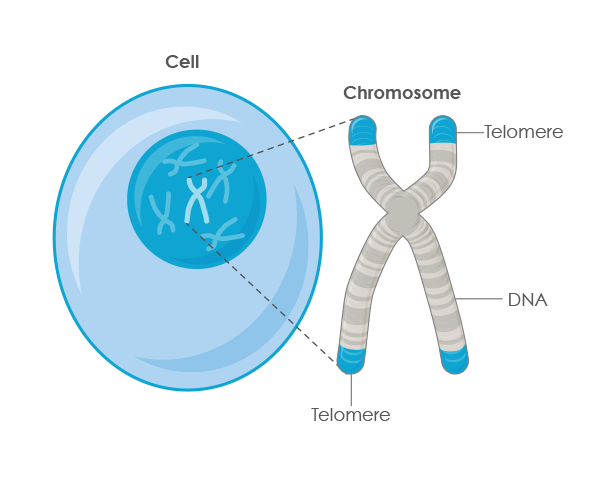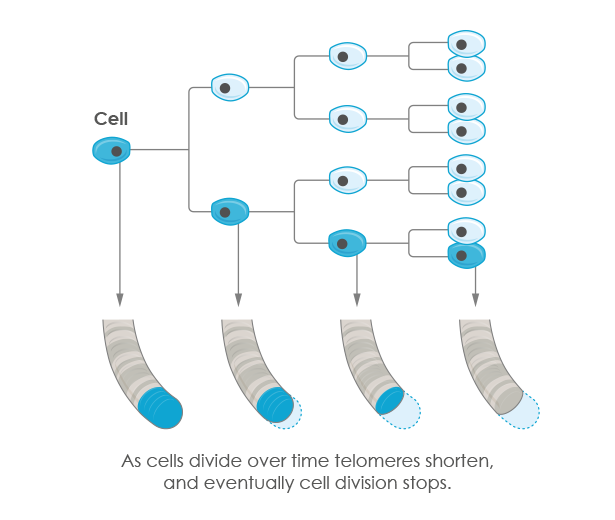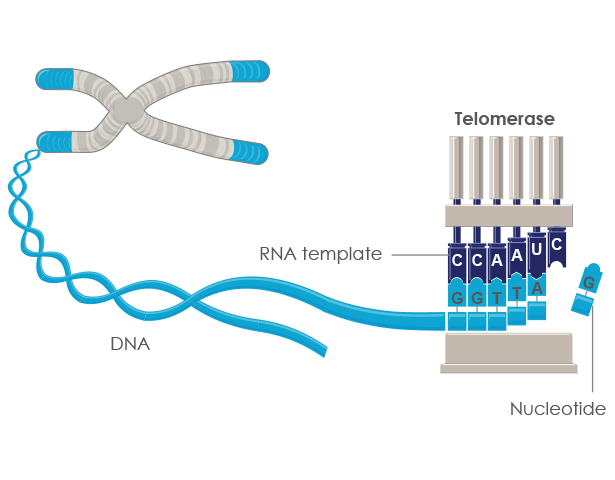Telomeres are an essential part of human cells that affect how our cells age. Telomeres are repeated sequences of DNA at the ends of each chromosome and are key genetic elements involved with the regulation of cell division. Telomerase is a naturally occurring enzyme that maintains telomeres and prevents them from shortening during cell division.
What are chromosomes?
Chromosomes are highly condensed rods of Deoxyribonucleic Acid (DNA), the genetic material which contains the building blocks of life. DNA carries a specific code that gives instructions to our body on how to grow, develop and function. The instructions are organized into units called genes. Chromosomes serve as the storage for this important material, periodically dividing along with cells and replicating to make copies of the DNA they contain.
Chromosomes are also very important in sexual reproduction, as they allow an organism to pass genetic material on to descendants. In organisms with cell nuclei, known as eukaryotes, chromosomes are found inside the nucleus.
Most of these organisms have a set of chromosomes which come in pairs. In structural cells, each cell retains a complete set of chromosomes, in what is known as diploid form, referring to the fact the chromosomes contain two copies of each gene. In cells for sexual reproduction like eggs or sperm, each cell only has half of the parent organism’s genetic material, stored in haploid form, ensuring that each parent passes down one copy of its genes.


What are telomeres?
The word Telomere (tel-uh-meer) comes from the Greek telos (end) and meros (part).
Telomeres are repeated sequences of DNA, along with their associated proteins, at the ends of each chromosome. The function of telomeres is to protect chromosome ends from chromosome fusions and degradation during the process of cellular replication, therefore, ensuring the proper functionality and viability of cells. Cell division plays a critical role in normal growth, maintenance and repair of all human tissues, including skin.
One common analogy is that telomeres are like the plastic caps at the end of shoelaces which keep the laces from unraveling. Without the coating, shoelaces become frayed until they can no longer do their job, just as without telomeres, DNA strands become damaged and our cells can’t do their job.
Telomeres shorten every time a cell divides, and once telomeres reach a critically short length, the cell either dies by apoptosis or stops dividing and senesces. Telomeres are shortened as we age, but telomeres can also be shortened by stress, smoking, obesity, lack of exercise and a poor diet.

What is telomerase?
Telomerase is a naturally occurring enzyme which is able to elongate telomeres and repair short telomeres by re-elongating them. To this end, telomerase adds telomeric repeats to the chromosome ends.
Telomerase, also called telomere terminal transferase, is a ribonucleoprotein that adds the polynucleotide “TTAGGG” to the 3’end of telomeres, at the ends of eukaryotic chromosomes. It is a reverse transcriptase enzyme that carries its own RNA molecule (with the pattern of ”CCCAAUCCC” in vertebrates), which is used as a template for adding new bases onto the ends of telomeres.
In non-pathological conditions telomerase is expressed in early stages of embryo development as well as in certain adult stem cell compartments. Telomerase is also highly expressed in pathological conditions, such as cancer, where it sustains the immortal growth of cancer cells. Healthy cells usually produce little or no telomerase and, as a consequence of this, they progressively shorten their telomeres with each successive cycle of cell division, until they reach a critically short length which triggers cell death or an irreversible cell arrest known as replicative senescence (also known as the Hayflick limit).
